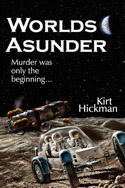by Kirt Hickman
 Last month we began to look at creative ways in which you can show your characters’ emotions effectively. To recap, we learned to:
Last month we began to look at creative ways in which you can show your characters’ emotions effectively. To recap, we learned to:
1. Use emotional honesty.
2. Convey the source of the emotion.
3. Avoid clichés.
4. Use metaphor.
This only scratches the surface of what you can do. Wherever you see the name of an emotion in your writing, question carefully whether you’re showing the emotion to the reader, or simply telling him about it. Here are more ways to show your characters’ emotions.1
5. Use Concrete Details
Not bugs, but locusts and flies. Not flowers, but crocuses, pansies, or marigolds. If your character is drinking soda or wine, name the brand (real or fictitious). If she’s reading a book or listening to a song, name it. Choose details that reflect your character’s emotional state.
Consider the following passage, from an early draft of my science fiction novel, Worlds Asunder. This shows Dana McKaughey’s first glimpse of Bill Ryan in the base trauma center after he’s been in a terrible accident.
Tubes and wires ran everywhere, to machines and equipment whose purpose she could only guess at.
Does this passage let you feel what Dana is feeling? No. It shows her ignorance of the equipment sustaining Bill, but it doesn’t convey emotion. Because she’s not familiar with the machines, I can’t describe them by name and function, but I can give details to the extent that she understands them.
Tubes and wires ran everywhere, from his arm, mouth ,nose, chest, and several from beneath a blanket that had been pulled down to his waist. Each connected him to equipment in his headboard.
Meaningless numbers and graphics lit the display. She heard the hollow pump and hiss of a respirator and a series of beeps with the rhythm of a steady heart, but she’d cautioned herself against false hope for too many hours to draw encouragement from the disembodied sounds.
Instead of wires just running everywhere, they now run from specific parts of Bill’s body to equipment in his headboard. Instead of settling for “machines and equipment,” I describe what Dana sees and hears in a manner that reflects her emotions.
6. Use Internal Monologue
This example is from Bill Ryan in Worlds Asunder:
Why couldn’t he share that part of her life? Whenever he tried, she was just responsive enough to make him think he had a chance. But in the end, she always kept him at arm’s length.
But Bill had resolved years ago not to psychoanalyze her behavior. He reminded himself of that pledge now to prevent his mind from slipping into that self-destructive mire of a woman’s emotional logic. Women’s prerogative, he repeated over and over again to make himself believe it. Some days it got to him more than others.
This shows more about his emotional state, and about him as a character, than words like frustration or loneliness could possibly convey.
7. Use Dialog
Consider this example from a critique submission.2
[Ian] reached the table just in time to get the last slice of mushrooms, olives, and green chili, much to the annoyance of his sister.
The author could have used dialog to show the girl’s annoyance.
[Ian] reached the table just in time to get the last slice of mushrooms, olives, and green chili.
“Mom,” Kasey yelled in her most whiney voice. “Ian took the last piece of good pizza.”
“You’re a kid. You’re not even supposed to like these toppings.” Ian made a show of stuffing half the piece into his mouth in a single bite.
“Mom,” Kasey yelled again.
The second passage reveals both characters much more clearly than the first, which simply tells the reader that Kasey is annoyed. The second passage shows, through dialog, how both characters respond to her annoyance.
8. Show Physical Response
The bodies, when he found them, were nothing more than a partial set of scorched bones and ash, incompletely cremated, with a few melted personal effects. Bile filled Chase’s throat and forced him to turn away. God damn it! Nobody was supposed to be in there. The death count was now at six, and Chase had known some of those people. He swallowed the vomit that rose in him, fortified his resolve, and looked again upon the victims. Both skulls remained intact, their bony grins mocking him from the ruins of his investigation. He imagined the perpetrator doing the same from somewhere nearby.
This passage from Worlds Asunder uses the involuntary response of Chase’s body to express his revulsion. Without it, the scene contains some macabre imagery, but it’s emotionally lifeless.
Read the rest of Kirt Hickman’s series:
“13 Ways to Show Character Emotions,” Part 1
“13 Ways to Show Character Emotions,” Part 3
1Ann Hood, Creating Character Emotions, Story Press Books, 1998.
2Excerpts from critique submissions are reprinted with the permission of the original author.
 Kirt Hickman is a technical writer turned fiction author. His books include three sci-fi thriller novels Worlds Asunder (2008), Venus Rain (2010) and Mercury Sun (2014), the high fantasy novel Fabler’s Legend (2011), and the writers’ how-to Revising Fiction: Making Sense of the Madness (2009).
Kirt Hickman is a technical writer turned fiction author. His books include three sci-fi thriller novels Worlds Asunder (2008), Venus Rain (2010) and Mercury Sun (2014), the high fantasy novel Fabler’s Legend (2011), and the writers’ how-to Revising Fiction: Making Sense of the Madness (2009).
This article was originally published in the July/August 2008 issue of SouthWest Sage, and is reprinted here by permission of the author.


























Leave a Reply